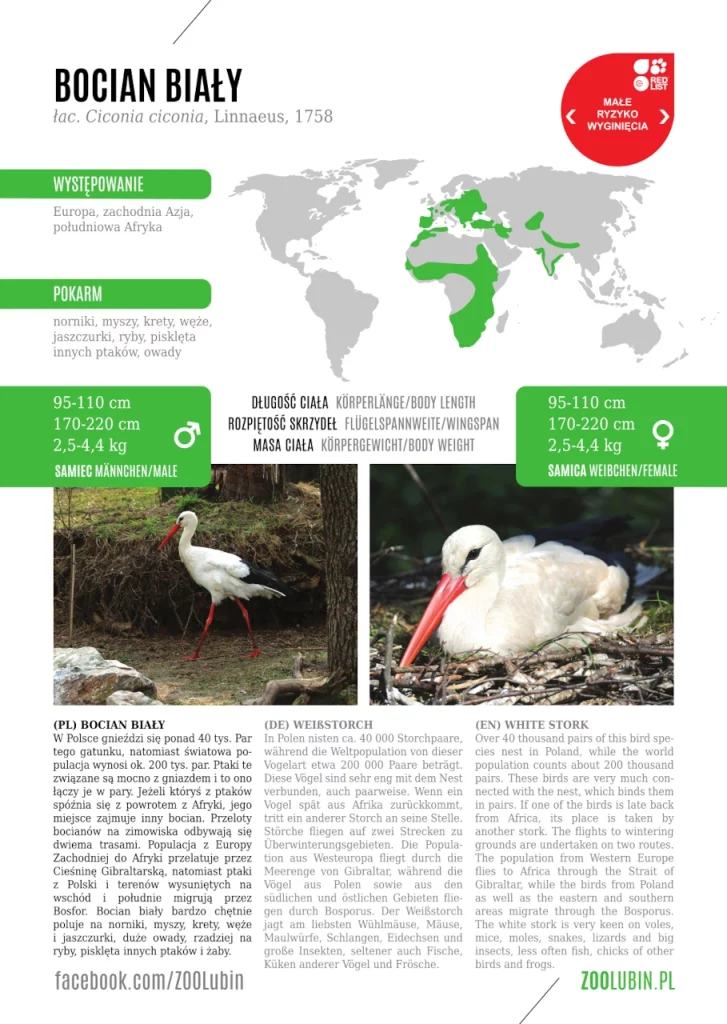
POBIERZ ETYKIETĘ GATUNKOWĄ – PLIK PDF (rozmiar 2995 KB)
Bocian biały (PL)
łac. Ciconia ciconia, Linnaeus, 1758
W Polsce gnieździ się ponad 40 tys. par tego gatunku, natomiast światowa populacja wynosi ok. 200 tys. par. Ptaki te są mocno związane z gniazdem i to ono łączy je w pary. Jeżeli któryś z ptaków spóźnia się z powrotem z Afryki, jego miejsce zajmuje inny bocian. Przeloty bocianów na zimowi-ska odbywają się dwiema trasami. Populacja z Europy Zachodniej do Afryki przelatuje przez Cieśninę Gibraltarską, natomiast ptaki z Polski i terenów wysuniętych na wschód i południe migrują przez Bosfor. Bocian biały bardzo chętnie poluje na norniki, myszy, krety, węże i jaszczurki, duże owady; rzadziej na ryby, pisklęta innych ptaków i żaby.
Występowanie: Europa, zachodnia Azja, południowa Afryka
samiec / samica
Długość ciała: 95–110 cm
Rozpiętość skrzydeł: 170–220 cm
Masa ciała: 2,5–4,4 kg
Weißstorch (DE)
łac. Ciconia ciconia, Linnaeus, 1758
In Polen nisten ca. 40.000 Storchenpaare, während die Weltpopulation etwa 200.000 Paare beträgt. Diese Vögel sind sehr eng mit dem Nest verbunden; es verbindet die Paare. Wenn ein Vogel zu spät aus Afrika zurückkommt, nimmt ein anderer Storch seine Stelle. Sie fliegen zu Überwinterungsgebieten auf zwei verschiedenen Strecken. Die Population aus Westeuropa reist durch die Meerenge von Gibraltar, während die Vögel aus Polen sowie aus den südlichen und östlichen Gebieten durch Bosporus fliegen. Der Weißstorch jagt am liebsten Wühlmäuse, Mäuse, Maulwürfe, Schlangen, Eidechsen und große Insekten; seltener auch Fische, Küken anderer Vögel und Frösche.
Vorkommen: Europa, Westasien, Südafrika
Männchen / Weibchen
Körperlänge: 95–110 cm
Flügelspannweite: 170–220 cm
Körpermasse: 2,5–4,4 kg
White stork (EN)
łac. Ciconia ciconia, Linnaeus, 1758
Over 40 thousand pairs of this species nest in Poland, while the world population counts about 200 thousand pairs. White storks are very attached to their nests; it is what binds them in pairs. If one of the birds is late back from Africa, its place is taken by another stork. The flights to wintering grounds are undertaken on two routes. The population from Western Europe flies to Africa through the Strait of Gibraltar, while the birds from Poland as well as the eastern and southern areas migrate through the Bosporus. The white stork is very keen on voles, mice, moles, snakes, lizards and big insects, more rarely it hunts fish, chicks of other birds and frogs.
Distribution: Europe, West Asia, South Africa
male / female
body length: 95–110 cm
wingspan: 170–220 cm
body mass: 2,5–4,4 kg
